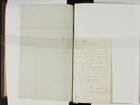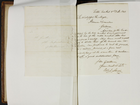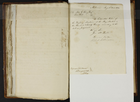Multimedia Content

Letter to Chairman of Market Committee from Charles Vaughan, 31 October 1843, courtesy of Public Record Office Victoria, Victorian Archives Centre.
Details
Letter to Mayor from Robert Ainslie, 3 October 1843, courtesy of Public Record Office Victoria, Victorian Archives Centre.
Details
Statement from Robert Pattinson and Thomas Salter, 23 August 1844, courtesy of Public Record Office Victoria, Victorian Archives Centre.
Details
Markets
Melbourne's markets play an important role in the retail economy of the city, and provide tourist and leisure opportunities for locals and visitors. The city's main markets have included the Western Market (1841) and the Eastern Market (1847), both defunct, and the Queen Victoria Market (1878), and Melbourne Wholesale Fruit and Vegetable Market (1969). Melbourne has also been served by fish markets, a hay and corn market and Metropolitan Meat Market, while suburban and regional markets were also established at Dandenong and Prahran (1864), South Melbourne (1867), and Preston (1970). An 1839 New South Wales Act empowered certain towns to establish markets, and market commissioners were elected in Melbourne in July 1841. A place for a market had been designated on Melbourne's original grid survey, and the site - also known as Market Square - was suitably located near the wharves and Customs House on the city block bounded by Market, Collins and William streets and Flinders Lane. Control of the Western Market, which opened as a general market (selling hardware, clothing and other wares as well as meat, fish, fruit and vegetables), was assumed by the Melbourne Town (later City) Council on its incorporation in 1842, and finally passed to a Market Trust in 1978. The smell and rubbish in surrounding city streets was a sign of market day, when the city came alive from the early hours of the morning as vendors brought their goods in from the market gardens that skirted the city, hawkers stocked up on produce, and householders scouted for bargains. While the English, Irish and Chinese dominated the fruit, vegetable and fish trades in the 19th century, Melbourne's postwar ethnic diversity has been reflected in the breadth of southern and eastern European- and Asian-style produce. Popular second-hand and art markets include the Camberwell Market, the Sunday Market at the Arts Centre and the St Kilda Esplanade Art and Craft Market.
- References
- Cole, Colin E. (ed.), Melbourne markets, 1841-1979: The story of the fruit and vegetable markets in the City of Melbourne, Melbourne Wholesale Fruit and Vegetable Market Trust, Melbourne, 1980. Details
- Ferguson, Jenny, A concise history of the Dandenong Markets, Heritage Planning, City of Greater Dandenong, Melbourne, 1998. Details
- Verheesen, Vienne, and Philip Hocking, Melbourne's marvellous markets: A comprehensive guide to 140 markets in and around Melbourne, V. Viviana, Melbourne, 1994. Details
